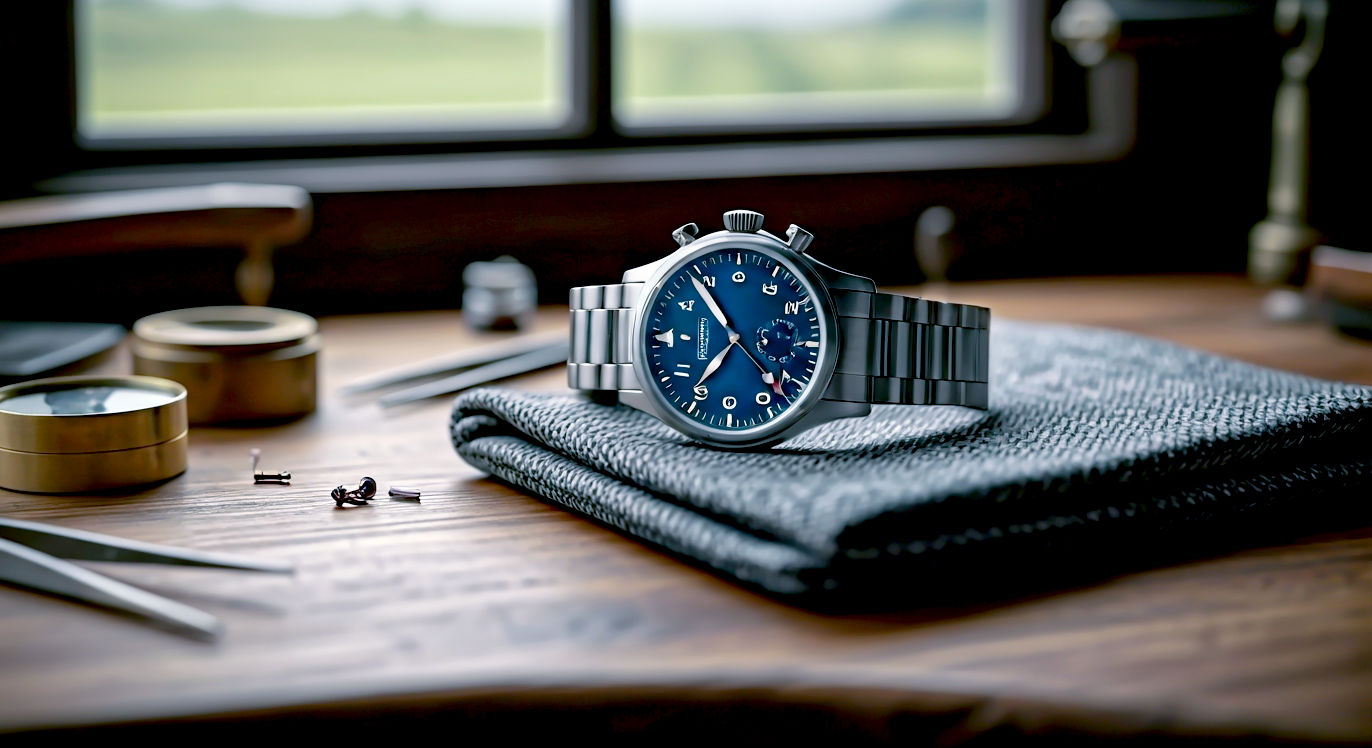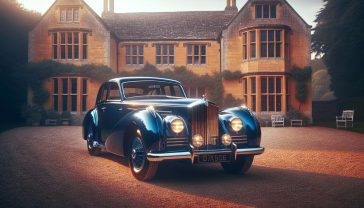The Refined World of British Luxury Watches: A Timeless Tradition
Your definitive guide to British luxury watches. From the golden age of Tompion and Harrison to the modern revival led by Bremont, explore the brands and history.

This post may contain affiliate links. If you make a purchase through these links, we may earn a commission at no additional cost to you.
If you’ve ever wondered what makes a truly great watch, you’re in the right place. It’s not just about telling the time. It’s about history, craftsmanship, and a story you can wear on your wrist. And when it comes to watchmaking, Britain has a story that’s as rich and fascinating as any in the world.
For centuries, Britain was the undisputed king of watchmaking. Long before the Swiss became famous for their timepieces, it was British inventors and artisans who were pioneering the technology that made accurate, portable clocks possible. From the pocket of a naval captain navigating the high seas to the wrist of a modern-day adventurer, British watches have been a mark of quality, innovation, and understated elegance.
But the story isn’t just about the past. After a period where it seemed the industry might fade away, British watchmaking has come roaring back to life. A new generation of brands is blending age-old skills with cutting-edge design, creating watches that are once again turning heads on the global stage.
This article is your complete guide to the refined world of British luxury watches. We’ll journey back in time to discover the golden age of British horology, meet the incredible figures who changed the world with their inventions, and explore the iconic brands—both old and new—that define British watchmaking today. We’ll look at what makes these timepieces so special, how they’re made, and what to look for if you’re thinking of owning a piece of this timeless tradition. So, let’s get started.
The Golden Age: When Britannia Ruled the Time Lords
It’s easy to think of Switzerland when we talk about luxury watches, but the real story of modern timekeeping began right here in Britain. For nearly 200 years, from the 1600s to the early 1800s, this island was the Silicon Valley of its day for watch technology. British clockmakers weren’t just the best; they were inventing the very tools and techniques that the rest of the world, including the Swiss, would later adopt.
The Birth of the British Watch
So, how did it all start? In the 17th century, London was a buzzing hub of science and discovery. Thinkers like Isaac Newton were figuring out the laws of the universe, and this spirit of invention spilled over into clockmaking. Early clocks were huge, heavy things found in church towers. The challenge was to make them smaller and, crucially, more accurate.
A huge breakthrough came from Robert Hooke, a brilliant scientist who invented the balance spring around 1660. This tiny, coiled spring allowed a watch’s balance wheel (the part that ticks back and forth) to oscillate at a steady, predictable rate. It was a game-changer. Suddenly, portable clocks—or ‘watches’—could be made far more accurately than ever before. This one invention is arguably the single most important development in the history of the watch.
Thomas Tompion: The Father of English Clockmaking
You can’t talk about this era without mentioning Thomas Tompion. Working in London in the late 1600s, Tompion was a master craftsman with an incredible mind for mechanics. He took Hooke’s balance spring and perfected it, creating watches of such quality and accuracy that he became a legend in his own lifetime. He was so respected that King Charles II became a patron.
Tompion’s workshops produced timepieces that were not just technically brilliant but also beautiful works of art. He introduced features we now take for granted, like numbering systems for his watches, making them easier to identify and repair. To own a Tompion was to own the very best. He was so revered that he was buried in Westminster Abbey—a rare honour for a craftsman.
George Graham and the Deadbeat Escapement
Following in Tompion’s footsteps was his apprentice, George Graham. Graham was another genius inventor. He refined the anchor escapement (a key part that controls the release of power in a clock) into the ‘deadbeat’ escapement. This new design was far more accurate because it stopped the pendulum or balance wheel from getting an extra ‘kick’ with each tick, which could throw off the timing.
Graham’s escapement was so good that it became the standard for precision clocks for the next 200 years. He also invented the first chronograph—a device that could measure intervals of time down to a fraction of a second. This was revolutionary for scientists and astronomers.
John Harrison and the Longitude Problem
Perhaps the most famous story from this golden age is that of John Harrison. In the 18th century, Britain was a great maritime power, but sailing was a dangerous business. Sailors could figure out their latitude (how far north or south they were) from the sun, but working out their longitude (how far east or west) was a massive problem. Get it wrong, and you could end up shipwrecked.
The British government offered a huge prize—millions of pounds in today’s money—to anyone who could solve the longitude problem. The answer lay in time. If a ship had a clock that could keep perfect time at sea, it could compare its local time (from the sun) with the time back in London (kept by the clock) to calculate its longitude.
The trouble was, no clock could withstand the violent motion of a ship and the changes in temperature and humidity. That is, until John Harrison, a humble carpenter from Yorkshire, came along. Over several decades, he built a series of incredible marine chronometers—H1, H2, H3, and finally, the one that cracked it, H4.
H4 was essentially a large, highly accurate pocket watch. It was tested on a voyage to Jamaica in 1761 and lost only 5.1 seconds over 81 days. It was a staggering achievement that saved countless lives and cemented Britain’s naval supremacy. Harrison’s work proved that British watchmakers were, without doubt, the best in the world.
The Rise of Mass Production and the British Decline
So, if Britain was so far ahead, what happened? In a word: industrialisation. While British watchmakers like Thomas Mudge, who invented the lever escapement in 1755 (the system still used in almost all mechanical watches today), continued to innovate, they focused on high-quality, handmade pieces. They were artisans, not factory owners.
Across the Atlantic, American watchmakers in the 19th century took a different approach. They started using machines to mass-produce watch parts. This made watches much cheaper. The Swiss saw which way the wind was blowing and quickly followed suit, building factories and organising their industry for mass production.
The British, proud of their handmade traditions, were slow to adapt. They couldn’t compete on price, and gradually, the Swiss and Americans took over the global market. By the end of the 19th century, Britain’s dominance was over. The golden age had come to an end, but its legacy of innovation and quality would never be forgotten.
The Great British Revival: A New Dawn for UK Watchmaking
For much of the 20th century, British watchmaking was a shadow of its former self. Famous names like Smiths, who made watches for the British military and Sir Edmund Hillary’s Everest expedition, eventually faded away in the face of cheaper imports and the ‘quartz crisis’ of the 1970s, when battery-powered watches almost wiped out the mechanical watch industry worldwide.
But you can’t keep a good tradition down. In the last couple of decades, something remarkable has started to happen. A new wave of passionate entrepreneurs and skilled watchmakers has sparked a great British revival. They are blending the nation’s rich horological heritage with modern technology and a distinctly British sense of style.
The Pioneers of the Modern Era
The revival didn’t happen overnight. It started with a few key figures who dared to dream of bringing watchmaking back home.
One of the most important is George Daniels. A self-taught genius, Daniels is widely considered the greatest watchmaker of the 20th century. Working from his quiet workshop on the Isle of Man, he single-handedly mastered all 32 skills required to create a watch from scratch. He is most famous for inventing the Co-Axial escapement in 1974. This was the first practical new watch escapement in 250 years, since Thomas Mudge’s lever escapement. It was a more efficient design that needed less servicing. After years of being turned down by the big Swiss brands, Omega finally adopted it in 1999, and it’s still a cornerstone of their watches today. Daniels proved that world-class innovation in watchmaking could still come from Britain.
His legacy lives on through his apprentice, Roger W. Smith. Based on the Isle of Man, Smith is one of the world’s finest independent watchmakers. He and his small team make just a handful of exquisite watches each year, entirely by hand. A Roger W. Smith watch is a masterpiece of traditional British craftsmanship, and owning one is the privilege of a very select few.
The Brands Leading the Charge
Inspired by the likes of Daniels and Smith, a new generation of British watch companies has emerged. They represent a broad spectrum, from accessible, design-led brands to high-end luxury watchmakers.
Bremont: The Aviation Trailblazers
Perhaps the best-known name in the modern revival is Bremont. Founded in 2002 by brothers Nick and Giles English, Bremont has a story rooted in aviation and adventure. The brand is famous for its incredibly tough, over-engineered pilot’s chronometers. Their slogan, “Tested Beyond Endurance,” isn’t just marketing hype. They subject their watches to extreme testing, including ejector seat launches and high-altitude flights.
Bremont has been at the forefront of bringing watch manufacturing back to the UK on a larger scale. They opened their state-of-the-art Manufacturing and Technology Centre, “The Wing,” in Henley-on-Thames, where they are now producing their own movements—the engines of the watch. This is a huge step, as most smaller brands have to rely on movements made in Switzerland or Japan. Bremont’s success has put British watchmaking firmly back on the map.
Christopher Ward: Affordable Luxury for All
At the other end of the price spectrum, but no less important, is Christopher Ward. Launched in 2005, their mission was to create high-quality, Swiss-made watches at fair prices by selling directly to customers online. While their watches are assembled in Switzerland, the design and engineering are proudly British.
Their big breakthrough came in 2014 when they unveiled their own in-house movement, the Calibre SH21. This was a massive achievement for a brand of their size and price point, proving that you don’t need a multi-million-pound budget to innovate. Christopher Ward offers incredible value and has introduced a whole new audience to the joys of luxury watch ownership.
Farer: A Splash of Colour
Injecting a dose of playful energy into the scene is Farer. Known for their bold and colourful designs, Farer watches are inspired by the spirit of travel and exploration from the mid-20th century. Their designs often feature vibrant dials with contrasting hands and numerals, giving them a unique and instantly recognisable look.
Like Christopher Ward, Farer combines British design with Swiss manufacturing to create high-quality timepieces that are full of character. They prove that serious watchmaking doesn’t have to be stuffy or overly serious.
Fears: A Legacy Reborn
The story of Fears is one of resurrection. The original Fears Watch Company was founded in Bristol in 1846 but closed its doors in the 1970s. In 2016, Nicholas Bowman-Scargill, the great-great-great-grandson of the founder, brilliantly re-established the company.
Today’s Fears watches are “elegantly understated,” with a design philosophy that blends heritage cues with contemporary style. They are designed in Britain and made in small batches, with a focus on quality and detail. The revival of Fears is a perfect example of how the new generation is reconnecting with Britain’s watchmaking past.
What Makes a British Watch ‘British’?
This is a great question, and the answer isn’t always simple. In today’s globalised world, very few products are 100% made in one country. A watch might be designed in London, use a movement from Switzerland, a case from Germany, and a strap from Italy. So what defines a truly British watch?
The Spectrum of ‘Britishness’
- Designed in Britain: This is the most common category. Many fantastic brands, like Farer and Christopher Ward, do all their design, research, and development here in the UK but rely on partners in Switzerland or Asia for manufacturing. This allows them to offer great quality at competitive prices.
- Assembled in Britain: Some brands take it a step further. They import components from around the world but carry out the final assembly and quality control in the UK. This gives them more oversight and allows them to label their products as “Made in Britain” (though the rules can be complex).
- Manufactured in Britain: This is the holy grail. It means a significant portion of the watch—especially the complex movement—is made in-house in the UK. This is incredibly difficult and expensive to achieve. Roger W. Smith is the ultimate example, making everything on his own island. Bremont is leading the way in doing this at a larger industrial scale with its ENG300 series movements. Vertex, another revived historic brand, also uses British-made movements in some of its high-end pieces.
The Unmistakable British Style
Beyond where the parts come from, there’s a certain character to British watches. It’s harder to define, but it’s often a blend of:
- Understated Elegance: British style tends to avoid being too flashy. Think classic designs, clean lines, and a focus on legibility and function. It’s a quiet confidence.
- A Connection to Heritage: Many British brands draw inspiration from the country’s history, whether it’s military, aviation, motorsport, or exploration. A Bremont watch feels connected to the cockpit of a Spitfire; a Fears watch has the feel of a gentleman’s timepiece from a bygone era.
- Robustness and Practicality: There’s often a built-to-last quality. British watches are designed to be worn and used, not just kept in a safe. This harks back to the days of Harrison’s marine chronometers—they were tools designed to do a tough job.
- A Touch of Eccentricity: Just as British culture has a quirky side, so do its watches. This might be a bold splash of colour from Farer or an unusual case design. It’s a willingness to be a little different from the mainstream.
A Look Inside: The Anatomy of a Luxury Watch
To truly appreciate what goes into a British luxury watch, it helps to understand a little about how they work. A mechanical watch is like a miniature city, with hundreds of tiny parts working together in perfect harmony, all powered by a wound spring—no batteries required.
The Movement: The Beating Heart
The movement, or calibre, is the engine of the watch. This is where the real magic happens. There are two main types of mechanical movement:
- Manual-Wound: This is the oldest type. You have to wind the crown every day or two to tighten the mainspring, which stores the power. Many watch purists love the daily ritual of winding their watch.
- Automatic (or Self-Winding): This is more common today. An automatic watch has a weighted rotor (a semi-circular piece of metal) that spins as you move your wrist. This spinning action winds the mainspring automatically, so as long as you wear it regularly, you’ll never have to wind it.
Key Components of the Movement
- Mainspring: A coiled spring that stores the watch’s energy. Winding the crown tightens it.
- Gear Train: A series of gears that transfers the energy from the mainspring to the escapement.
- Escapement: This is the part that makes the ticking sound. It’s the brain of the watch, controlling the release of power from the mainspring in tiny, precise bursts. The most common type is the lever escapement, a British invention. The balance wheel and hairspring are key parts of the escapement system.
- Balance Wheel and Hairspring: This is the timekeeping element. The balance wheel swings back and forth at a very precise rate (usually 6 to 8 times a second), regulated by the tiny, coiled hairspring. Each swing of the wheel allows the gear train to advance just a little bit, moving the hands forward.
Complications: More Than Just Telling Time
In watchmaking, a complication is any function on a watch that does more than tell the hours, minutes, and seconds. They showcase a watchmaker’s skill. Some common complications include:
- Date: Shows the date of the month, often in a small window.
- Chronograph: A stopwatch function, usually with pushers on the side of the case to start, stop, and reset.
- GMT or Dual Time: Shows the time in two or more time zones at once, perfect for travellers.
- Moonphase: A beautiful display that shows the current phase of the moon.
The more complex the complication, the more difficult and expensive the watch is to make.
Finishing: The Art of Decoration
What often separates a good watch from a great one is the finishing. This refers to the decoration and polishing of the movement’s components. Even parts you’ll never see are often meticulously decorated with patterns like Côtes de Genève (Geneva stripes) or perlage (circular graining).
This isn’t just for looks. A well-finished movement with polished surfaces creates less friction and can improve accuracy and longevity. It’s a mark of true craftsmanship and a sign that no corners have been cut. Independent makers like Roger W. Smith are masters of traditional English finishing, which often has a frosted, gilded look that is distinct from Swiss styles.
How to Choose Your First British Luxury Watch: A Buyer’s Guide
Thinking of investing in a piece of British watchmaking history? It’s an exciting prospect, but it can also be a bit daunting. Here are a few practical tips to help you find the perfect watch for you.
1. Set Your Budget
British watches are available at a wide range of price points.
- Entry-Level Luxury (£500 – £1,500): In this range, you’ll find fantastic options from brands like Christopher Ward and Farer. You’ll get a high-quality watch, likely with a reliable Swiss-made movement and excellent design.
- Mid-Range Luxury (£1,500 – £5,000): This is where you start to see more established brands like Bremont, Fears, and Vertex. You might find watches with more complex features, higher levels of finishing, and in some cases, the beginnings of in-house movement manufacturing.
- High-End Luxury (£5,000+): This is the territory of top-tier Bremont models with their in-house movements, limited editions, and the world of independent watchmaking. At the very top end, a watch from Roger W. Smith can cost hundreds of thousands of pounds and have a years-long waiting list.
2. Think About Your Style and Lifestyle
What will you be using the watch for?
- The Everyday Watch: You’ll want something versatile and durable. A classic field watch or a simple three-hand watch on a steel bracelet or a leather strap is a great choice. Look for good water resistance (at least 100 metres) and a scratch-resistant sapphire crystal.
- The Dress Watch: For more formal occasions, a slimmer, more elegant watch is ideal. These are typically simpler (often time-only or with a date), smaller in diameter, and worn on a leather strap. Brands like Fears excel at this.
- The Sports Watch: If you have an active lifestyle, you’ll need something tough. Pilot’s watches from Bremont or dive watches from Christopher Ward are built to take a beating. They’ll have features like high water resistance, excellent legibility, and robust construction.
3. Do Your Research on the Brand
Part of the joy of owning a luxury watch is the story behind it. Read up on the brands that interest you. Do you connect with Bremont’s adventurous spirit, Farer’s colourful designs, or Fears’ resurrected heritage? Choosing a brand you admire makes the ownership experience much more meaningful.
4. Understand the Movement
As we’ve discussed, the movement is the heart of the watch. At entry-level price points, you’ll likely be getting a reliable ‘off-the-shelf’ movement from a Swiss manufacturer like Sellita or ETA. There is absolutely nothing wrong with this—they are proven workhorses.
As you move up in price, you might see brands modifying these movements or, in the case of Bremont and Christopher Ward, offering their own in-house calibres. An in-house movement is often seen as more prestigious and shows a brand’s technical capability, but it will also come at a premium.
5. Try It On
This is crucial. A watch can look completely different in photos than it does on your wrist. The diameter of the case is one thing, but you also need to consider the lug-to-lug distance (the measurement from the top of the case to the bottom). This often has a bigger impact on how a watch wears than the diameter alone.
If you can, visit a retailer to try on different models. See how it feels, how it sits on your wrist, and how easy it is to read. A great watch should feel like an extension of you.
The Future of British Watchmaking: What’s Next?
The British watch industry has come an incredibly long way in a short space of time. But what does the future hold? The momentum is strong, and the trajectory looks positive.
A Return to True Manufacturing: The biggest trend is the continued drive towards “vertical integration”—doing more of the manufacturing process in-house. Bremont’s investment in its UK factory is a massive statement of intent. As more brands follow suit, we’ll see the ‘Made in Britain’ label carry even more weight. This will help re-establish the UK as a genuine force in global horology.
Collaboration and Community: The British watch scene is quite close-knit. There’s a sense of camaraderie and a shared mission to rebuild the industry. We’re seeing collaborations between brands and suppliers, helping to create a domestic supply chain for parts like cases, dials, and hands that has been missing for decades.
Sustainability and Innovation: Like all modern industries, watchmaking is becoming more conscious of its environmental impact. Brands are looking at using recycled materials and ensuring their supply chains are ethical. There’s also room for technical innovation, perhaps in new materials or a modern re-interpretation of classic British escapements.
A Growing Appreciation for Craft: In a world of smartwatches and disposable tech, the appeal of a beautifully made mechanical object is stronger than ever. A mechanical watch is a connection to a tangible skill, a piece of history, and something that can be passed down through generations. The British watch industry, with its rich heritage and focus on quality, is perfectly placed to meet this growing demand.
The story of British watches is a story of incredible highs and challenging lows. It’s a tale of genius inventors, patient craftsmen, and visionary entrepreneurs. From the workshops of 17th-century London to the high-tech manufacturing centres of today, the spirit of British horology endures. It’s a tradition that has been reborn, revitalised, and is now ticking more strongly than it has in over a century. Owning a British watch today isn’t just owning a fine timepiece; it’s owning a part of that remarkable comeback story.
Further Reading and Resources
For those looking to delve deeper into the world of British watches, these resources are highly recommended:
- The British Horological Institute (BHI): The professional body for clock and watchmakers in the UK. Their website is a great resource for the history and technical aspects of the craft. https://bhi.co.uk/
- WatchPro: A key trade publication for the UK watch industry, offering news and analysis on the latest developments. https://www.watchpro.com/
- The Alliance of British Watch and Clock Makers: An organisation dedicated to promoting and supporting the sector within the UK. https://www.britishwatchmakers.com/






